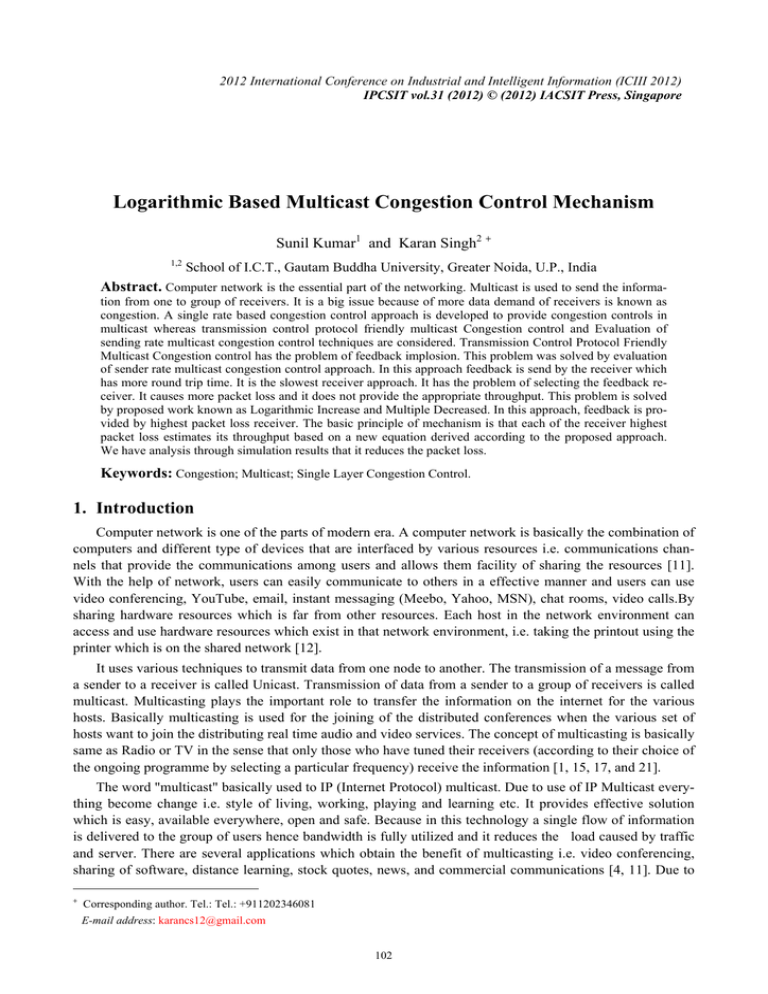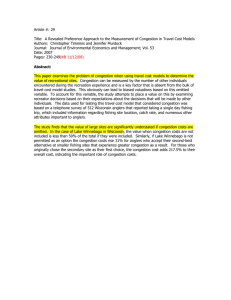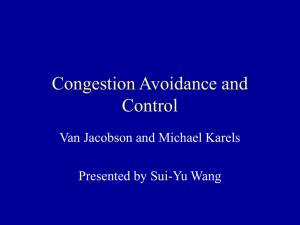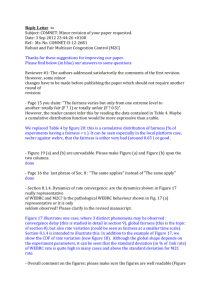Logarithmic Based Multicast Congestion Control Mechanism Sunil Kumar and Karan Singh
advertisement

2012 International Conference on Industrial and Intelligent Information (ICIII 2012) IPCSIT vol.31 (2012) © (2012) IACSIT Press, Singapore Logarithmic Based Multicast Congestion Control Mechanism Sunil Kumar1 and Karan Singh2 + 1,2 School of I.C.T., Gautam Buddha University, Greater Noida, U.P., India Abstract. Computer network is the essential part of the networking. Multicast is used to send the information from one to group of receivers. It is a big issue because of more data demand of receivers is known as congestion. A single rate based congestion control approach is developed to provide congestion controls in multicast whereas transmission control protocol friendly multicast Congestion control and Evaluation of sending rate multicast congestion control techniques are considered. Transmission Control Protocol Friendly Multicast Congestion control has the problem of feedback implosion. This problem was solved by evaluation of sender rate multicast congestion control approach. In this approach feedback is send by the receiver which has more round trip time. It is the slowest receiver approach. It has the problem of selecting the feedback receiver. It causes more packet loss and it does not provide the appropriate throughput. This problem is solved by proposed work known as Logarithmic Increase and Multiple Decreased. In this approach, feedback is provided by highest packet loss receiver. The basic principle of mechanism is that each of the receiver highest packet loss estimates its throughput based on a new equation derived according to the proposed approach. We have analysis through simulation results that it reduces the packet loss. Keywords: Congestion; Multicast; Single Layer Congestion Control. 1. Introduction Computer network is one of the parts of modern era. A computer network is basically the combination of computers and different type of devices that are interfaced by various resources i.e. communications channels that provide the communications among users and allows them facility of sharing the resources [11]. With the help of network, users can easily communicate to others in a effective manner and users can use video conferencing, YouTube, email, instant messaging (Meebo, Yahoo, MSN), chat rooms, video calls.By sharing hardware resources which is far from other resources. Each host in the network environment can access and use hardware resources which exist in that network environment, i.e. taking the printout using the printer which is on the shared network [12]. It uses various techniques to transmit data from one node to another. The transmission of a message from a sender to a receiver is called Unicast. Transmission of data from a sender to a group of receivers is called multicast. Multicasting plays the important role to transfer the information on the internet for the various hosts. Basically multicasting is used for the joining of the distributed conferences when the various set of hosts want to join the distributing real time audio and video services. The concept of multicasting is basically same as Radio or TV in the sense that only those who have tuned their receivers (according to their choice of the ongoing programme by selecting a particular frequency) receive the information [1, 15, 17, and 21]. The word "multicast" basically used to IP (Internet Protocol) multicast. Due to use of IP Multicast everything become change i.e. style of living, working, playing and learning etc. It provides effective solution which is easy, available everywhere, open and safe. Because in this technology a single flow of information is delivered to the group of users hence bandwidth is fully utilized and it reduces the load caused by traffic and server. There are several applications which obtain the benefit of multicasting i.e. video conferencing, sharing of software, distance learning, stock quotes, news, and commercial communications [4, 11]. Due to + Corresponding author. Tel.: Tel.: +911202346081 E-mail address: karancs12@gmail.com 102 increasing the demand of applications, demand of more bandwidth and maximum throughput also increase. It causes the problem of congestion in network. Basically network congestion occurs when the number of transmitted message exceeds the capacity of the network. In other words, congestion problem in the network The main cause of overloading of network are capacity of memory, buffer space, bandwidth of channel, processing capacity, number of users , failure of link, etc. and it continuously leads the condition of congestion. So the requirement of mechanism to managing the situation of congestion is increasing. Congestion can be reduce or control by applying existing techniques [2, 13, 21, 22] such as ERMCC [7], MTCP [8], PLM [9], PGMCC [6], FLIDDL [18], etc. It is the era of networking, and the demand of computer networking is increasing day by day. In recent years text was used to send the information but now the demand of video data i.e. video conferencing, YouTube, IPTV etc is increasing. The robustness of the current Internet is due, in large part to the end-to-end congestion control mechanism of transmission control protocol (TCP) [6, 7, 8, 9]. It is generally known that TCP dominates current Internet operations as it represents 90% of traffic. Due to this demand of bandwidth is increasing to handle the huge amount of traffic. User want quality of service (minimum delay, maximum throughput, minimum delay and minimum loss).So the problem with load balancing occurs. To overcome there are several techniques but it is a big issue now due to video on demand increasing [4]. Due to more demand of data more number of users increases. It causes the problem of more bandwidth. It creates the problem of congestion in the network Our research most probably will be dedicated to covers only Multicast Congestion Control (MCC) problems, and in particular, this work is interested only in single rate base multicast congestion control. . The rest of the paper is organized as follows. Section 2 deals with related work whereas section 3 details the proposed solution and section 4 discussions with analysis of results. Finally, section 5 deals with concluding remarks. 2. Related Work Multicast congestion is basically the essential thought in the case of internet protocol multicasting. It is the era of more bandwidth applications because the demand of video data is increasing in comparison to audio data and text data. It consumes more bandwidth in comparison to audio and text data. As the number of users is increasing the requirement of bandwidth also increase. Due to more demand of data, problem of congestion occur. In the congestion control approaches there is need to provide the feedback to the senders that sending rate could be adjusted. There is needing of reliability i.e. file transfer but on the other hand i.e. videoconferencing then it does not matter because it can bear some losses. The problem exists in the case of heterogeneous receivers because there is need to satisfy requirements i.e. bandwidth, quality of service and round trip time for the different receivers. Congestion control and quality of service are the main issues on the internet for the fast exploitation of video applications. In this section, we review and discuss the most important congestion control and quality of service scheme for the multicast video applications on the internet. In single rate adjustment approach for the particular session same transmission rate is adjust at each and every link. It takes the feedback from the receivers and adjusts its transmission rate. It is basically used in the real world scenarios. But problem of scalability still present because in the presence of heterogeneous receivers the slowest receiver could create the problem of the link utilization and transfer rate for the other receivers. Single rate multicast congestion control approaches are very effective and easily applied but these have some limitations i.e. it provide the good results when the number of receivers are less and all have approximately same requirements. Explicit Rate Multicast Congestion Control (ERMCC) [7], Pragmatic General Multicast Congestion Control (PGMCC) [6] and TCP Friendly Multicast Congestion Control (TFMCC) [8] are the single rate protocols which are used to control the congestion in multicast networks. They adjust the sending rate dynamically. The rate of slowest receiver is adapted so that congestion could be avoided. When the number of receivers increased, in that case bandwidth and congestion adjustment create the problem. TCP friendly multicast congestion control (TFFMC) [8]is the extend version of the TCP friendly rate control (TFRC) [22] protocol. TFFMC is basically an equation-based single-rate protocol which is applied in 103 the multicast domain. In TFRC basically sender adjusts its transmission based on the losses event rate. On the other hand, In TFMCC we calculate the steady state throughput of each and every receiver. Then sending rate is adjusted based on the slowest receiver in the particular session i.e. Current limiting receiver. It is concluded that TFMCC is easy, simple, scalable multicast congestion control mechanism . Evaluation of sending rate multicast congestion control (ERMCC) [5] is the single rate multicast congestion control technique in which transfer rate is measured when congestion detected. Source basically adopts a congestion representative (CR) dynamically among the slowest receivers and feedback is considered for the rate adaptation. To choose the CR, firstly throughput rate is calculated at each receiver after that an average rate is selected, based on that CR is chosen. TFMCC is basically a single rate multicast congestion control technique. It uses the steady state equation to adjust the throughput. But this mechanism has the problem of Feedback implosion. It creates the congestion at the source side. This problem was solved by ESRMCC approach. In this approach feedback is taken by the receiver which has more RTT (Round Trip Time). But it is slow when there is change in the network state. It is the slowest receiver approach and bandwidth is not fully utilized after occurrence of congestion. The number of packet loss is more and it does not provide the appropriate throughput. This problem is solved by Logarithmic Increase and Multiple Decreased (LIMD). In this approach feedback is provided by highest packet loss receiver. It is an improved version of the ESRMCC approach, which is an equation-based congestion control technique. 3. Proposed Work In single rate based multicast congestion control approach the data is transferred at the same rate to all the receivers. In this approach feedback is taken from all the receivers and then sending rate is adjusted. There is the problem of scalability when the different receivers have different requirement [14], [16]. Single rate multicast congestion control approaches are very effective and easily applied but these have some limitations i.e. it provide the good results when the number of receivers are less and all have approximately same requirements. The existing approach ESRMCC is using Adaptively Increase and Multiplicative Decrease equation [5, 10]. Basically source increase and decrease the sending rate based on Adaptively Increase and Multiplicative Decrease. The problem with this approach is to selecting the feedback receiver and it consume more time and it results congestion at the source side. Due to additively increasing the source rate bandwidth utilization is less and decreases the performance of the network. To solve the problem of existing one, we have use logarithm mechanism for increasing and decreasing the rate when congestion occurred. To control the congestion and provide the better utilization of the network Logarithmic Increase and Multiplicative Decrease is used. The proposed work is known as Logarithmic Increase and Multiplicative Decrease (LIMD) congestion control. The proposed mechanism is discussed in section 3.1. 3.1. Logarithm Based Multiple Decrease In this approach feedback is provided by highest packet loss receiver. It is an improved version of the ESRMCC approach, which is an equation-based congestion control technique. Algorithm 1: LIMD STEP 1: 100 S; STEP 2: 200 RTT; STEP 3: α S/RTT; STEP 4: β 0.65; STEP 5: p 0.1:1; STEP 6: do Xn β*log2*(1+ α/p); STEP 7: Initialize ∆B, D, Cf; STEP 8: do Cf 1- ∆B/D; Xn* Cf ; STEP 9: Xn+1 STEP 10: While (True) STEP 11: do if (X >Rc) STEP 12: status Congestion Elseif status Underutilize //Control Congestion STEP 13: if (status == Congestion) && (∆B >0) Xn* Cf Xn+1 104 STEP 14: Elseif (∆B <0) Xn Xn+1 STEP 14: else (status == Under Utilize) End It improves in throughput and reduces the packet losses. If there is packet size 100 bytes, round trip time 200 millisecond, loss event ratio 0.1 and if there is no congestion in the network then sending rate is increased by increasing factor alpha and if there is congestion in the network the rate is decreased by reduction factor beta. To prevent the congestion, congestion factor is calculated and if congestion occurs then new throughput is adjusted based on the multiplication of the previous and congestion factor. The following equation 1 is used for the throughput calculation. X=β log2 (1+ α/ρ)……………………………… ………….(1) Where β: reduction factor, α=S/RTT, S: packet size, RTT: round trip time, ρ: loss event ratio, Cf: congestion factor, dn : delay for the current packet, dn-1: delay for the current packet, Xn+1: throughput after congestion, Xn: throughput before congestion, dmax: maximum delay in the whole process, dmin: minimum delay in the whole process. The complete flow graph of proposed work is shown in figure 1 and the algorithm 1 is given for proposed work. 4. Result and Discussion In this section simulation has been carried out to evaluate the performance of the proposed approach. The key parameters for performance measurement are packet loss and throughput. Fig 1: Flow Chart of LIMD Fig 2: Multicast Topology 4.1. Simulation Environment The proposed work is simulated in NS-2 [19].It is one of the goals to make a simulation environment for demonstrating the single rate based approach. For this simulation Centos Operating system was used. The system has Intel Core 2 Quad CPU 2.67 GHz, RAM 4GB, 32 bit Operating system. Figure 2 is the multicast topology which is used to generate the result. The results parameters which used in simulation are given in table 1. 4.2. Results Analysis We have simulated the proposed work and exist one. We have analyses the effect of various parameters on throughput and packet loss. The discussions regarding these parameters are given below. Table 1: Simulation Parameters Parameter Explanation Value Parameter Explanation Value S p Packet size Loss event ratio 100-600 (Bit) 0.1-0.9 B.W W.S Bandwidth window size 1.5-10 (Mb) 15 (Bit) β Reduction factor 0.65-1.5 α Increasing factor 0.5-0.9 105 Effect on throughput in LIMD Variation in ALPHA (α) The figure 2 shows the throughput performance at different time for different values of increasing factor (α) between 0.5 and 0.9.where X-axis shows the time (sec) and Y-axis demonstrate the throughput in kbps. However, the magnitude of throughput fluctuations is higher with value of α =0.5 and decreases when value of α increases due to variation in the network condition. It occurs due to the variations in the packet size and round trip time. Every packet takes different time to reach the destination. Fig 2: Variation in Factor (α) Fig 3: Variation in Factor (β) Variation in BETA (β) The figure 3 shows the throughput performance at different time for different values of decreasing factor (β) between 0.65 and 1. Where X-axis shows the time (sec) and Y-axis demonstrate the throughput in kbps. However, the magnitude of throughput fluctuations is higher with value of β=0.65 and it decreases as well as increases the value of reduction factor changes. It occurs due to the effect of decreasing factor alpha, congestion in the network and variation the round trip time which basically affected by the delay in the network. Variation in Packet size(S) The figure 4 shows the throughput performance at different time for different values of Packet size(S) between 100 and 600. Where X-axis shows the time (sec) and Y-axis demonstrate the throughput in kbps. However, the magnitude of throughput fluctuations some times higher as well lower. It decreases as well as increases as the value of Packet size(S) changes. It is due to the variation in the network conditions i.e. occurrence of congestion in the network. Packet size basically depends upon the size of data it contains. Fig 4: Variation in Packet size(S) Fig 5: Comparison of Packet Loss Comparison of Packet Loss The figure 5 shows the comparison of Packet Loss at different time as anticipated by TFMCC, ESRMCC and LIMD. Where X-axis shows the time (sec) and Y-axis demonstrate the Packet Loss. Figure 6.11 shows the packet loss among i.e. among LIMD, ESRMCC and TFMCC. TFMCC concerned with feedback from all the receivers. It creates the problem of congestion. There is more packet loss in TFMCC due to slow response to the network state changes. ESRMCC is basically deals with CLR (current Limiting Receiver). It 106 takes the feedback from more round trip time receiver. As the round trip time varies feedback providing receiver changes. It is clear that it provide the slow response when RTT changes. It causes congestion in the network. But there is less packet loss in comparison to the TFMCC. Whereas that of LIMD deals with the highest packet loss receiver. Further the shape shows that the magnitude of loss fluctuations of LIMD is considerably lesser compared to ESRMCC and TFMCC. It is also considered that if the link of bottleneck becomes congested, losses increases. 5. Conclusion In this proposed approach the network source adapts the network feedback. This is sent by highest packet loss receiver and increase or decrease throughput based on the steady state equation. Basically LIMD is an improved version of the ESRMCC approach, which is an equation-based single-rate multicast congestion control technique. The basic principal is that each of the receiver estimates its throughput based on a new equation derived according to the proposed work. We have analysis the simulated results and observe that proposed approach improves in throughput; reduce rate fluctuations, RTT, and reduces the packet loss. When increasing and decreasing factor varies but in the case of ESRMCC, it is in the range of 32 to 50 kbps. Hence the throughput is good. On the other hand packet loss is very less. It basically 40% decreases as compared to TFMCC, 30% decreases as compared to ESRMCC approach. 6. References [1] Christos Bouras, Georgios Kioumourtzis et. al “Performance Evaluation of sender rate multicast congestion control scheme for MPEG-4 Video Transmission” International conference on Computers and Communications (ISCC), pp. 540– 545, 2010. [2] Miguel Rodríguez-Pérez, Manuel Fernández-Veiga et. al. “A Receiver Based Single-Layer Multicast Congestion Control Protocol for Multimedia Streaming” Performance of Computer and Communication Networks, Vol.3042/2004, pp.550-561, 2004. [3] Mohammad Rabby, Kaliappa Ravindran et. al. “Distributed Adaptation algorithms for Rate-controlled Video Multicast over Shared Infrastructure Networks” Second International Conference on Communication Systems and Networks (COMSNETS), pp.1 – 11, Bangalore , 18 March ,2010. [4] "Multicast Deployment Made Easy", Cisco, Design Implementation Guide IP Multicast Planning and Deployment Guide, 1998, http://www.cisco.com, Last accessed 02/02/2011. [5] Kammoun W, Youssef H “Equation-based end-to-end single-rate multicast congestion control” Annals of Telecommunications,Volume 65,16 February 2010. [6] L. Rizzo, L. Vicisano, and M. Handley, “PGMCC single rate multicast congestion control: Protocol specification,” draft-ietf-rmt-bb-pgmcc-01.txt, February 2001. [7] Jiang Li, Murat Yuksel et.al. “Explicit rate multicast congestion control” Computer Networks: The International Journal of Computer and Telecommunications Networking, Volume 50 Issue 15, Elsevier North-Holland, Inc. New York, NY, USA, 18 October 2006. [8] J. Crowcroft, L. Rizzo, et al. "TCP- like Congestion Control for Layered Multicast Data Transfer" Proc. of INFOCOM 1998. [9] A. Legout and E . Biersack, "PLM: Fast Convergence for Cumulative Layered Multicast Transmission Schemes , " Proc. of SIGMETRICS, pp.13-22, 2000. [10] Kammoun, W., Youssef, H. “An Adaptive Mechanism for End-to-End Multirate Multicast Congestion Control” The Third International Conference on Digital Telecommunications, pp. 88-93, July 2008. [11] RFC 3246, “An Expedited Forwarding PHB,” http://www.ietf.org/rfc/rfc3246.html, last accessed 25/03/2011. [12] Optivity Policy Services, http://www.nortelnetworks.com/products/01/optivity/policy. html, last accessed 20/03/2011. [13] RFC 5166, S. Floyd, “Metrics for the Evaluation of Congestion Control Mechanisms”, Network Working Group, March 2008. [14] Tatsuya, 'Subjective video quality assessment for adaptive quality-of-service control'. IEEE International Conference on Multimedia and Expo (icme) 2001. [15] Y. Al-Sbou, R. Saatchi, S. Al-Khayatt and R. Strachan,“Estimation of the distributions of the QoS parameters using sampled passive measurements techniques” Procedings of the Second International Conference on eBusiness and Telecommunication Networks (ICETE), Reading, UK, Oct. 3-7, 2005. [16] F. Fitzek, P. Seeling, and M. Reisslein, “Video streaming in wireless Internet”, Wireless Internet: Technologies 107 [17] [18] [19] [20] [21] [22] and Applications Series: Electrical Engineering & Applied Signal Processing Series, 2004. Rohaly M. et.al. “Video Quality Experts Group: Current Results and Future Directions”, In: SPIE Visual Communications and Image Processing, Perth, Australia, June 21-23, 2000, Vol. 4067, p.742-753. J. Byers, G. Horn, M. Luby, M. Mitzenmacher, and W. Shaver, “FLIDDL:Congestion Control for Layered Multicast,” IEEE J-SAC Special Issue on Network Support for Multicast Communication, vol. 20(8), pp.1558–1570, Oct. 2002, A preliminary version appeared in NGC ’00. http://www.isc.org/solutions/survey last accessed on 28/01/2011. http://www.cisco.com/en/US/products/ps6552/products_ios_technology_home.html last accessed 20/01/2011. Christos, Bouras Apostolos Gkamas et. al “Comparison of Single-Rate Multicast Congestion Control Protocols vs. ASMP” International conference on Modeling, Analysis and Simulation of Computers and Telecommunication Systems, MASCOTS , 8-10 Sep. 2008. RFC 4654, “On TCP-friendly Multicast Congestion Control (TFMCC)”, J. Widmer, M. Handley, July 2008. 108




